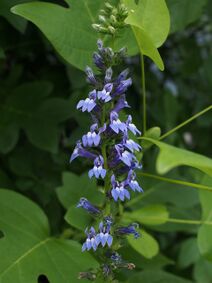Lobelia siphilitica
| Lobelia siphilitica | |
 | |
| Light: | |
| Moisture: | |
| Hardiness: | 5 |
| Soil pH: | 5.6-8.4 |
| Height: | 3' |
| Width: | 1' |
| Blooms: | Late Summer-Early Fall |
| Native to: | |
| Nectary | |
| Medicinal Rating: | |
| Tea: | Yes |
Lobelia siphilitica (common name: great blue lobelia) is a short-lived forb.[1] The plant is potentially poisonous[2] as it contains the alkaloid lobeline which has a similar effect upon the nervous system as nicotine.[3]
Propagation: Seed - best sown as soon as it is ripe in a cold frame[4]. When they are large enough to handle, prick the seedlings out into individual pots and grow them on in the greenhouse for their first winter. Plant them out into their permanent positions in late spring or early summer, after the last expected frosts.
Division in spring[4].
Basal cuttings in spring[5]. Harvest the shoots when they are about 10cm long with plenty of underground stem. Pot them up into individual pots and keep them in light shade in a cold frame or greenhouse until they are rooting well. Plant them out in the summer.
Layering in moist sand, it forms roots at the nodes[4].
Cultivation: Requires a moist soil, succeeding in full sun or partial shade[6][7][4].
Range: Eastern N. America - Maine to S. Dakota, south to Texas and Missouri.
Habitat: Moist woods and marshes[7].
Medicinal: The root is cathartic, diaphoretic and emetic[8][9][10]. It is used in the treatment of dropsy, diarrhoea, stomach complaints, syphilis and dysentery[8][11]. A poultice of the root has been applied to sores that are hard to heal[11].
The leaves are analgesic and febrifuge[11]. An infusion has been used in the treatment of colds and fevers[11]. A poultice of the crushed leaves has been applied to the head to relieve the pain of headaches[11].
At one time in N. America the root of this plant was believed to be effective in the treatment of VD.[10][2] When used in Europe, however, it was found to be ineffective[12]. This might have been because the N. American Indians used the fresh root (which still contained the volatile oils) and also used it in conjunction with Podophyllum peltatum and Prunus virginiana, and then dusted the ulcers with the bark of Ceanothus americanus.[12]
It was believed by some native North American Indian tribes that if the finely ground roots were secretly added to the food of an arguing couple then this would avert a divorce and they would love each other again.[12]
A homeopathic remedy is made from the roots.[8]
Soil: Can grow in light, medium, and heavy soils.
Flower Type: Hermaphrodite
Links
References
- ↑ Thomas, Graham. Perennial Garden Plants. J. M. Dent & Sons, 1990.
- ↑ 2.0 2.1 Foster, Steven and Billy Tatum. Medicinal Plants of Eastern and Central North America. Houghton Mifflin, 1990.
- ↑ Diggs, George and Barney Lipscomb. Illustrated Flora of North Central Texas. Botanical Research Institute, 1999.
- ↑ 4.0 4.1 4.2 4.3 Huxley, Anthony. The New Royal Horticultural Society Dictionary of Gardening. MacMillan Press, 1992.
- ↑ Chittendon, Fred. RHS Dictionary of Plants. Oxford University Press, 1951.
- ↑ Sanders, Thomas. Popular Hardy Perennials. Collingridge, 1926.
- ↑ 7.0 7.1 Phillips, Roger and Martyn Rix. Perennials - The Definitve Reference. Pan Books, 1991.
- ↑ 8.0 8.1 8.2 Grieve, Margaret. A Modern Herbal. Penguin, 1984.
- ↑ Uphof, Johannes. Dictionary of Economic Plants. Weinheim, 1959.
- ↑ 10.0 10.1 Heywood, Vernon. Flowering Plants of the World. Oxford University Press.
- ↑ 11.0 11.1 11.2 11.3 11.4 Moerman, Daniel. Native American Ethnobotany. Timber Press, 1998.
- ↑ 12.0 12.1 12.2 Weiner, Michael. Earth Medicine, Earth Food. Ballantine Books, 1980.